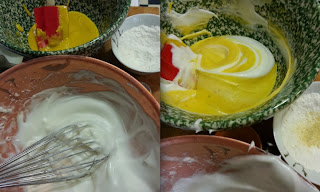I'm calling this lime-ginger melon
marmalade, instead of jam (as
last time) because, while I liked the flavor of the jam (based on Jane Grigson't
Fruit Book recipe), I didn't like how the chunks of melon became dense. This time, instead of cubing the melon, I julienned it (four pounds of it, this was a huge cantaloupe). This was in hope—and with success—that the strips would have more of a marmalade consistency instead of a cubes-in-syrup one.
This makes ten pints, and can easily be halved: 4 lbs julienned melon, about ¼-in. thick (your choice: Grigson specifies green-fleshed but I've always used orange-fleshed varieities), 7 oz. ground fresh ginger (I sliced it across the grain and then processed it in a food processor), 1 lb. limes, rind finely julienned and fruit set aside for later (lemon works too, but just use the zest; lime rinds are thin enough that the whole rind works), 4 lbs sugar.
Mix the sugar with the melon, add the lime and ginger, and let sit 6-8 hours or overnight in a non-reactive bowl (glass, ceramic, etc.).
This is what it looks like after sitting and turned into its cooking vessel (above).
Heat the fruit-sugar mixture, and add the reserved limes, tied up in cheesecloth. Cook, stirring frequently, until it reaches 220º (F) on a thermometer, then remove and press any liquid from the cores of the limes. Continue cooking, testing occasionally to see if it will set (place ½ tsp. on a chilled saucer, leave in freezer for two minutes: this will tell you if it is ready). I cooked this until it was around 224º (F). Process in a
hot-water bath for 15 minutes.
The strips of melon resulted in a wonderful texture, and the ginger and lime give it a wonderful kick. Perfect with a croissant.



















































